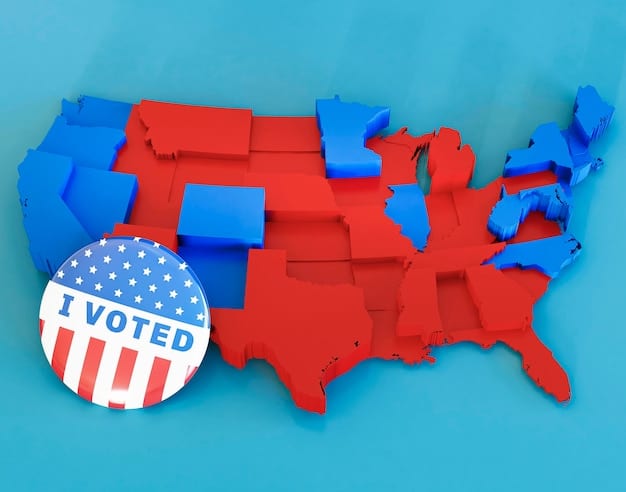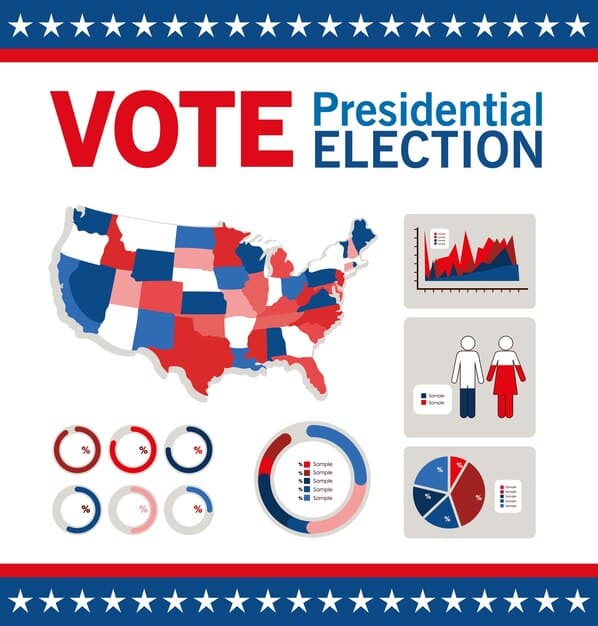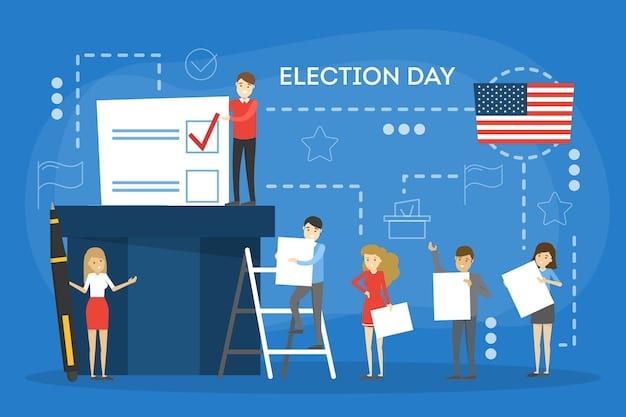Understanding the Electoral College: Reforms and How It Works

The Electoral College is a process, not a place, established by the U.S. Constitution for electing the president and vice president, where instead of directly voting for a candidate, citizens vote for a slate of electors who then cast the actual votes.
The **Understanding the Electoral College: How Does It Work and Could It Be Reformed?** is a cornerstone of the American presidential election system, yet it remains a subject of intense debate and scrutiny. This system, established by the U.S. Constitution, determines how the president and vice president are chosen, and its unique structure often leads to questions about fairness, representation, and democratic ideals.
What is the Electoral College?
The Electoral College is a body of electors chosen by voters in each state, who then cast the actual votes for president and vice president. This system was created by the Founding Fathers as a compromise between electing the president by popular vote and electing the president by a vote in Congress.
How Electors are Chosen
Each state is allocated a number of electors equal to its total number of representatives in Congress (House + Senate). Political parties in each state nominate candidates for elector. How these candidates are chosen varies by state and party, but it often involves party conventions or committees.
The Role of Electors
When you vote in a presidential election, you are technically voting for these electors who have pledged to support a particular candidate. In almost all states, the candidate who wins the popular vote receives all of that state’s electoral votes. This is known as the “winner-take-all” system.

Faithless Electors
While electors are pledged to a particular candidate, there have been instances of “faithless electors” who vote for someone else. However, many states have laws to prevent or penalize this.
- Electors are chosen by the parties in each state.
- Voters technically vote for electors.
- Most states use a winner-take-all system.
- Faithless electors are rare but possible.
In summary, the Electoral College is a system where electors, rather than individual citizens, directly elect the president. This system involves the selection of electors, their pledge to a candidate, and the winner-take-all approach used in most states, though the possibility of faithless electors adds a layer of complexity.
The Mechanics of the Electoral College
Understanding the mechanics of the Electoral College involves knowing how electoral votes are allocated, how the winner is determined, and how the process unfolds from Election Day to the inauguration.
Allocation of Electoral Votes
Each state gets a number of electors equal to its total number of senators (always two) and representatives in the House, which is based on population. The District of Columbia also gets electors, as if it were a state, though it has no voting representation in Congress. The total number of electors is 538.
The Magic Number: 270
A candidate needs a majority of electoral votes to win the presidency. With 538 total electoral votes, the magic number to win is 270. If no candidate reaches 270, the election is decided by the House of Representatives.
The Electoral Process
On Election Day, voters cast their ballots. After the election, each state counts its popular votes to determine which candidate won. The governor then certifies the results and appoints the winning candidate’s pledged electors. These electors meet in December to cast their votes.
January Certification
In January, Congress meets in a joint session to count the electoral votes. The Vice President, as President of the Senate, presides over this session. Once the votes are counted and certified, the winner is officially declared.

The Electoral College process ensures that a candidate must win a majority of electoral votes to become president. This involves allocating votes based on state representation, the popular vote in each state, and the final certification by Congress.
Historical Context of the Electoral College
To fully understand the Electoral College, it’s essential to delve into its historical origins and the reasons why the Founding Fathers established this unique system. The historical context provides crucial insights into the debates and compromises that shaped the U.S. Constitution.
The Founding Fathers’ Dilemma
During the Constitutional Convention of 1787, the Founding Fathers debated various methods for electing the president. They considered direct popular vote, election by Congress, and election by state legislatures. Each option had its drawbacks, and the Electoral College emerged as a compromise.
Concerns About Direct Democracy
Some Founders feared that direct democracy would lead to a “tyranny of the majority,” where the most populous states would always dictate the outcome. They worried that a president elected solely by popular vote might not consider the interests of smaller states or regions.
Slavery and Representation
The issue of slavery also played a significant role. Southern states wanted enslaved people to be counted for representation in Congress but not for the purpose of taxation. The Three-Fifths Compromise counted enslaved people as three-fifths of a person for both representation and taxation, influencing the allocation of electoral votes.
Protecting Against Uninformed Voters
The Founding Fathers also had concerns about the average citizen’s knowledge and judgment. They believed that an Electoral College of informed, elite individuals would be better equipped to choose a qualified leader. This was a reflection of the era’s social and political norms.
- The Electoral College was a compromise during the Constitutional Convention.
- It addressed fears of the tyranny of the majority.
- Slavery and representation influenced its design through the Three-Fifths Compromise.
- Founders worried about the knowledge and judgment of average voters.
Understanding the historical context of the Electoral College reveals that it was a product of compromise, addressing various concerns related to direct democracy, state representation, slavery, and the perceived limitations of the electorate. This historical perspective is critical for evaluating the system’s ongoing relevance and potential reforms.
Arguments For and Against the Electoral College
The Electoral College is a topic of continuous debate, with strong arguments both for and against its existence. Understanding these arguments is crucial for forming an informed opinion about its role in modern American democracy.
Arguments in Favor
Proponents of the Electoral College argue that it protects smaller states by ensuring their voices are heard in presidential elections. Without it, candidates might focus solely on densely populated areas, ignoring the needs and concerns of less populated states. It also promotes national unity by requiring candidates to build broad coalitions across different regions.
Arguments Against
Critics argue that the Electoral College can lead to a president being elected without winning the popular vote, undermining the principle of “one person, one vote.” This has happened in several elections, most recently in 2000 and 2016, leading to questions about the legitimacy of the outcome. Some also argue that it depresses voter turnout in states where the outcome is perceived as predetermined.
Impact on Campaign Strategy
The Electoral College significantly influences campaign strategy. Candidates focus their resources on swing states, where the election is expected to be close. This means that voters in these states receive disproportionate attention, while those in reliably blue or red states may feel ignored.
Potential for Disparity
The disparity between the popular vote and the electoral vote can lead to political division and a sense that the system is unfair. This can erode trust in government and democratic institutions. It also raises questions about whether the Electoral College truly reflects the will of the people, especially in a polarized political climate.
The arguments for and against the Electoral College highlight fundamental differences in how people view representation, fairness, and the role of government. While proponents emphasize the protection of smaller states and national unity, critics focus on the potential for undermining the popular vote and creating political division.
Potential Reforms to the Electoral College
Given the ongoing debate surrounding the Electoral College, various reform proposals have been suggested over the years. These proposals seek to address perceived flaws in the system while preserving some of its original intent.
National Popular Vote Interstate Compact
The National Popular Vote Interstate Compact is an agreement among states to award their electoral votes to the candidate who wins the national popular vote. It would go into effect once states representing a majority of electoral votes (270) join the compact. This approach aims to achieve a national popular vote without a constitutional amendment.
The feasibility of the National Popular Vote Interstate Compact is a hotly debated topic, with legal challenges and political hurdles to overcome before it can be implemented.
Proportional Allocation of Electoral Votes
Some propose that states should allocate their electoral votes proportionally based on the popular vote within the state. For example, if a candidate wins 60% of the vote, they would receive 60% of the state’s electoral votes. This approach could more closely align electoral votes with the popular vote but could also lead to more contested elections.
Changing to a proportional vote allocation system would likely require a constitutional amendment and support from both political houses and each state.
Abolishing the Electoral College
The drastic approach would be to amend the constitution to remove the electoral college. This proposal would involve electing the president by national vote only. This is a simple and direct solution, but would require widespread political support.
- National Popular Vote Interstate Compact: States agree to award electoral votes to the national popular vote winner.
- Proportional Allocation: States allocate electoral votes based on the proportion of the vote that each candidate wins.
- Constitutional amendment: Removing the electoral college completely, leaving just a national vote.
In summary, there are various reform proposals aimed at addressing the perceived flaws of the Electoral College. These range from interstate compacts to proportional allocation of electoral votes, each with its own set of advantages and disadvantages. These reforms would likely require political consensus and legal validation.
The Future of the Electoral College
The future of the Electoral College remains uncertain, as the debate over its merits and drawbacks continues to evolve. Understanding the possible scenarios and challenges is crucial for anyone following American politics.”
Political Polarization and the Electoral College
The current climate of political polarization could intensify calls for reform, especially if future elections result in a significant disparity between the popular vote and the electoral vote. The sense of unfairness and disenfranchisement that can arise from such outcomes could fuel further debate and activism.
Demographic Shifts and Representation
Demographic shifts within the United States could also influence the debate over the Electoral College. As populations grow or shrink in different states, questions about fair representation and the balance of power between states will likely persist. Such shifts could lead to renewed efforts to reform or abolish the Electoral College.
Influence of Third Parties and Independents
The influence of third-party candidates and independent movements could play a role in the future of the Electoral College. If a third-party candidate were to win a significant number of electoral votes, it could disrupt the traditional two-party system and force a reevaluation of the Electoral College’s role in ensuring a clear and decisive election outcome.
Challenges to Reform
Reforming or abolishing the Electoral College faces significant challenges. It would likely require a constitutional amendment, which requires broad consensus and support from both political parties. In addition, smaller states that benefit from the Electoral College are likely to resist changes that could diminish their influence. Overcoming these challenges would require careful negotiation and compromise.
The future of the Electoral College will depend on a combination of factors, including political polarization, demographic shifts, the influence of third parties, and the challenges of achieving meaningful reform. These elements will shape ongoing debates about its role in American democracy and whether it should be reformed or retained.
| Key Aspect | Brief Description |
|---|---|
| 🗳️ Electoral College | A system where electors, chosen by voters, cast the actual votes for president. |
| 📜 Historical Context | Established by Founding Fathers as a compromise, addressing fears of direct democracy and state representation. |
| ⚖️ Arguments | Supporters say it protects smaller states; critics argue it can undermine the popular vote. |
| 🔄 Potential Reforms | Include the National Popular Vote Interstate Compact, proportional allocation, or abolishing the Electoral College. |
Frequently Asked Questions
▼
A candidate needs at least 270 electoral votes to win the presidency. This represents a majority of the total 538 electoral votes available.
▼
If no candidate reaches 270 electoral votes, the House of Representatives elects the president from the top three candidates, with each state delegation having one vote.
▼
Yes, a candidate can win the popular vote but lose the election if they do not secure at least 270 electoral votes. This has happened in several U.S. presidential elections.
▼
The National Popular Vote Interstate Compact is an agreement among states to award their electoral votes to the candidate who wins the national popular vote, regardless of the state’s vote.
▼
The Electoral College was created as a compromise between electing the president by popular vote and electing the president by a vote in Congress, balancing the interests of populous and less populous states.
Conclusion
In conclusion, the Electoral College remains a complex and controversial aspect of the American political system. From its historical origins to the ongoing debates about its fairness and effectiveness, understanding the Electoral College is essential for informed participation in civic life. As discussions about potential reforms continue, the future of this unique institution will undoubtedly shape the course of American democracy.





